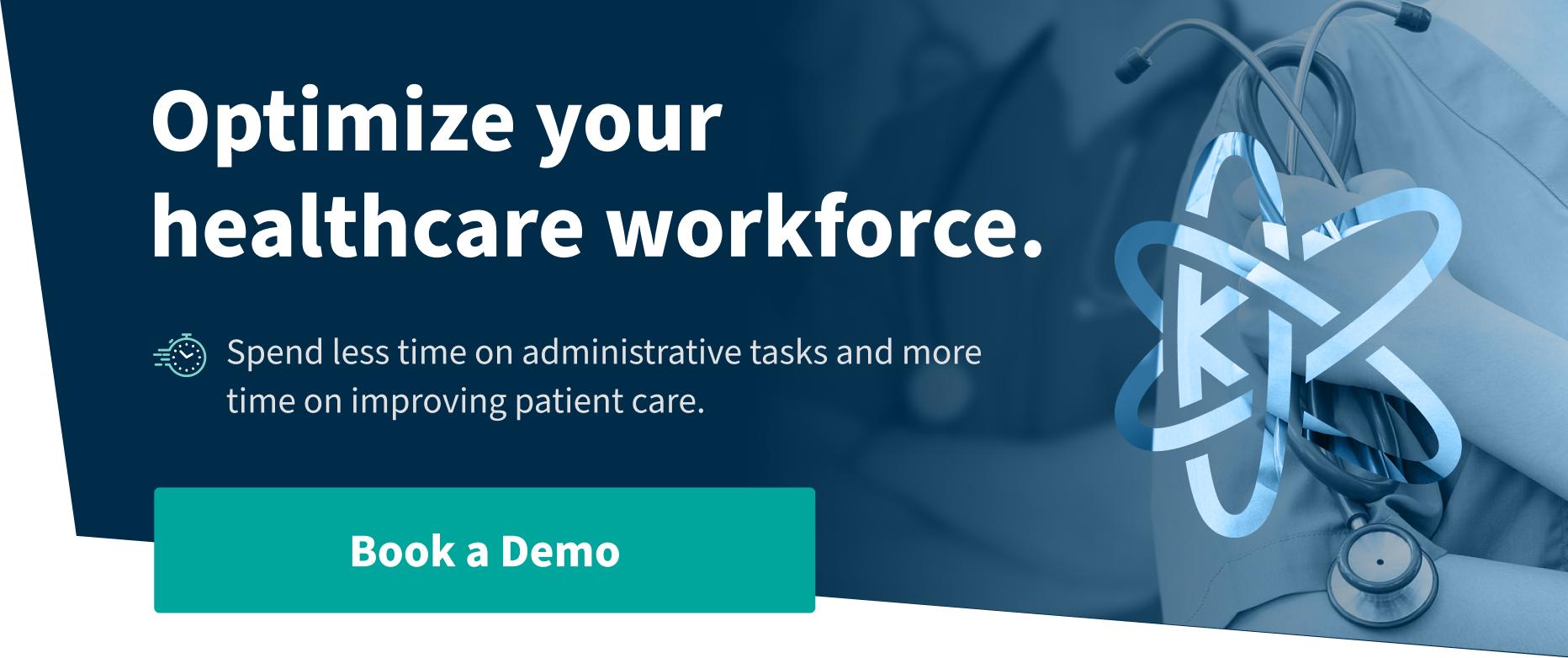Skyrocketing healthcare labor costs are an enormous challenge for healthcare organizations just like yours. As burnout increases and shortages soar, organizations are relying more and more on premium contract staff like locums to fill these critical gaps.
Budgets are getting bloated and overworked teams and patients are all suffering from the churn. Is it any surprise staff members are quitting in record numbers when they are overworked?
Your team might be one of the many in the healthcare workforce that are suffering from the endless cycle of spending and disruption. If we had to guess, you are looking for a way to ease the burden of the current state of affairs. In the meantime, demand rises but supply can’t keep up, so you pay premium rates for temporary contractors. The bills are piling up even as care quality and staff morale drops from overloaded teams and rotating providers.
What if I told you there’s a better way to handle things? Perhaps the talent needed to prevent this premium staff over-reliance is already within your network. With some workforce optimization you can stretch your current team’s capacity to reduce overspending by up to 20% or more. Even better is that you can accomplish this without increasing burnout! Cross-training, smoother coordinating, proactive planning, cross-credentialing and balancing workloads are the keys that will unlock your existing potential.
If you’re ready to stop feeling powerless amidst the hiring crisis, keep reading as we share five tips to amplify that under-leveraged workforce you already have. Let’s take back control of labor costs and care continuity together! The solutions start from within.
The Elephant in the Room - The Impact of High Premium Labor Costs
Like an elephant crowding a tiny room, the downstream effects of sky-high contract labor costs trample healthcare organizations in avoidable ways. Let’s address the behemoth consequences in the healthcare workforce.
Financial Burden
Ballooning agency physicians spend strains already limited budgets. Zip Recruiter estimates physicians earn a national average of $131/hour. This means each agency resource can cost your organization as much as $400/hour or more - between approximately 1.5 and three times the fees associated for a permanent staff member with travel. Based on these numbers, hospitals can shell out as much as $16k-$20k/week per contractor, further crippling budgets. Where can resources go when temporary staff monopolize funds?
Plummeting Provider Satisfaction
Like putting a bandaid on a wound that needs surgery, relying on agency labor actually worsens understaffing. It also overloads your remaining team members with unrelenting demands. Clinicians burn out from impossible workloads and recharting for transient peers. Morale and retention spiral amid lack of support.
Without intervention, excessive premium labor dependence will continue trampling care continuity, destroy finances and fracture overburdened staff. So where do you begin?
6 Tips to Reduce Your Healthcare Labor Costs
There are several ways you can reduce premium labor spend, but here are just five of the most popular tips our clients have used:
- Use Staffing and Schedule Data to Forecast Open Shifts
- Forecast Workforce Needs
- Cross-Credential Internal Team
- Build Robust Rosters of Multi Labor Types
- Automate Workflows
- Measure Outcomes
Now that you know the five tips, let’s break them down further so you can lower your healthcare labor costs!
1. Use Staffing and Schedule Data to Forecast Open Shifts
Fragmented staff data across outdated spreadsheets and calendars results in scheduling guesswork. It’s better to consolidate your entire workforce dataset for credentials, availability, skills, and past performance in one place. Connect the dots to gain complete visibility. Suddenly bottlenecks and unused capacity become clear, leading to smarter optimization.
Using a system like Kimedics makes quick work of this task.
2. Forecast Workforce Needs Proactively
Leveraging analytics and algorithms for data-backed projections of patient volume, referral trends and staffing models lets you pivot nimbly. Combine historical data with real-time external insights across facilities for accurate staff planning. Rather than reacting to surprises down the line, proactively adapt schedules and mix based on reliable models.
3. Cross-Train Internal Team - Incentivize Internal Flexibility
Does your team realize their cross-training potential? If not, it’s a good idea to develop multi-specialty “float pools” within your core staff before resorting to temporary contracts. Incentivize existing talent to expand skill sets with advancement opportunities and tuition support. Invest in amplifying your internal capacity and gain budget relief.
4. Build Robust Rosters of Multi Labor Types
It’s critical to build robust rosters of multi labor types including core, casual internal and agency. Healthcare organizations need partnerships with agencies to ensure care continuity. You also need one system for managing internal and temporary labor in one place to make the most optimal decisions.
5. Automate Workflows
Don’t let manual drudgery limit your rockstar healthcare administrators and providers. Relieve the busywork burden through digital workflow and document automation, scheduling assistance, and vendor collaboration tools. Let your team focus on high-value tasks automated technology handles faster.
6. Measure Outcomes - Track Savings with Analytics
How can you improve what you don’t measure? Make labor cost management visibility a priority. Consistently evaluate metrics like cost and revenue per shift, overtime rate trends and agency spending mix. Ensure you course correct issues driving excess external hiring with data-driven insights.
With small but mighty changes —centralizing data, forecasting proactively, incentivizing internal flexibility, automating workflows and tracking analytics— your existing staff transform into a cost-saving powerhouse. Optimize internally before turning outward!
How Kimedics Helped a 100+ Physician Group Reduce Premium Labor Spend by 20%
Kimedics recently started working with a 100+ physician group that relied heavily on internal staffing, filling 95% of around 1,000 monthly shifts with permanent doctors. However, management lacked the tools to fully optimize internal resources before bringing on premium locums for schedule gaps.
When they started centralizing real-time roster data and open shift visibility on the Kimedics platform, the group was able to better broadcast needs internally before engaging costly external agencies. With a few clicks, their organization was able to set up flexible workflows that allowed the scheduler to easily share openings with internal providers first based on up-to-date availability statuses, rate differentials across facilities, and more.
Within months the organization reduced monthly locum usage from 10 shifts to nearly zero. By tapping into dormant internal capacity with transparent data, Kimedics allowed the group to save more than $300,000 on their premium healthcare labor costs. The expanded internal coverage prevented care delays from transient staff turnover as well. Permanent physicians also benefited from reduced weekend/overnight burdens.
This is one of the many success stories Kimedics can offer illustrating the fact that even medical groups staffed mostly by internal workforce can find hidden flexibility to minimize premium labor oversight. The kicker though is that it requires real-time visibility and efficient communication tools to unlock.
Ideas for Optimizing Workflows and Automation
If saving sounds good to you, here are some additional ideas that might help you with optimizing workflows and automation in your healthcare organization:
Streamline scheduling with automated systems.
Automated scheduling software like Kimedics can save scheduler time, improve visibility into open shifts, and make it easier to fill gaps with internal staff first. This optimization alone can reduce premium labor usage by 10-20%.
Digitize paper-based records and workflows.
Transitioning records like credentials, team member availability, and timesheets to digital formats eliminates manual handling and makes the information accessible in real-time. Automated expirations tracking and notifications also helps keep docs compliant.
Leverage e-Signature tools for faster document completion.
E-Signatures through secure mobile apps save providers time and hassle when completing paperwork required for onboarding, credentialing, enrollment, and more. Everything gets wrapped up faster.
Set up custom workflows across teams.
Collaboration platforms like Kimedics allow you to define automated cross-team workflows with custom roles, permissions, alerts and approvals. Tailored SOPs increase efficiency.
Tap analytics for productivity insights.
Dashboards that track key metrics around provider shift volume, patient revenue, and margin per clinical hour help you pinpoint savings opportunities and prevent overspending scenarios.
Key Takeaways and Next Steps
To quickly recap, in this post we covered several strategies groups can employ to control runaway healthcare labor costs through better leveraging internal teams.
- Centralize fragmented staffing data onto a unified platform for full workforce visibility
- Forecast hiring needs accurately based on patient volume projections
- Incentivize internal provider cross-training for schedule flexibility
- Automate cumbersome scheduling, documents and vendor workflows
- Consistently measure margin per shift metrics to pinpoint savings opportunities.
Simple adjustments like these can yield considerable cost reductions. Imagine saving $100,000, $200,000 or even $300,000 annually by optimizing internal staff coverage before turning to premium labor. Optimized workflows can easily translate into an extra 50 hours or more saved every month for schedulers that are bogged down by manual tasks.
To learn more about how Kimedics’ modern workforce management platform can unlock serious labor cost savings for your organization, we invite you to book a personalized demo today. Our team of experts will dive into your current physician staffing workflows, identify improvement areas, and project cost reduction impact through leveraging your wider provider network.
Now is the time to finally gain control of your premium labor spend and redirect those savings to patient care initiatives that really matter. Get started with Kimedics today!


